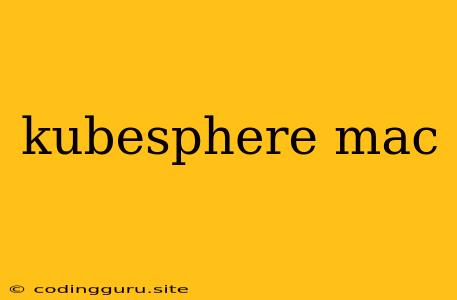KubeSphere on Mac: A Comprehensive Guide
KubeSphere is an open-source container platform that simplifies the management and deployment of containerized applications on Kubernetes. If you're a Mac user and want to explore the capabilities of KubeSphere, this guide provides a step-by-step approach to setting up and using KubeSphere on your system.
Why Choose KubeSphere for Mac?
KubeSphere empowers Mac users with a user-friendly interface for Kubernetes, eliminating the need for complex command-line interactions. It streamlines common tasks such as:
- Deploying and managing applications: Create and deploy containerized applications with ease, including microservices and web applications.
- Monitoring and troubleshooting: Gain real-time insights into the health and performance of your applications and Kubernetes cluster.
- Security and access control: Securely manage user roles and permissions, ensuring only authorized users can access sensitive resources.
- DevOps automation: Automate your deployment workflows using continuous integration and continuous delivery (CI/CD) tools.
Setting up KubeSphere on Mac
-
Prerequisites:
- Docker Desktop: Download and install the latest version of Docker Desktop for Mac.
- VirtualBox: KubeSphere requires a virtual machine for the Kubernetes cluster. Install VirtualBox.
- KubeSphere Installer: Download the KubeSphere installer for your operating system.
-
Install KubeSphere:
- Open the downloaded KubeSphere installer.
- Follow the on-screen instructions to install KubeSphere. You'll be prompted to configure the virtual machine and the KubeSphere cluster.
- Ensure that the required ports are open on your Mac for KubeSphere to function properly.
-
Access KubeSphere:
- Once the installation is complete, access the KubeSphere dashboard through your web browser. The default address is usually
http://localhost:30880. - You may need to log in with the default credentials provided during the installation.
- Once the installation is complete, access the KubeSphere dashboard through your web browser. The default address is usually
Using KubeSphere on Mac
- Create a project: Create a new project to organize your applications and resources.
- Deploy applications: Deploy your containerized applications to the cluster using the KubeSphere platform.
- Manage resources: Manage the resources within your project, such as deployments, services, and ingresses.
- Monitor applications: Use the built-in monitoring tools to track application performance and identify any issues.
- Automate workflows: Configure CI/CD pipelines for automated deployments and updates.
Troubleshooting
- Network connectivity: Ensure your Mac is connected to the internet and that the required ports are open.
- Virtual machine issues: If you encounter problems with the virtual machine, try restarting it or reinstalling it.
- KubeSphere installation errors: Refer to the KubeSphere documentation for troubleshooting steps.
Key Features of KubeSphere
- Multi-tenancy: Manage multiple users and projects, each with their own set of permissions.
- Visualized dashboard: A user-friendly dashboard provides an overview of your cluster, applications, and resources.
- Automated deployment: Use CI/CD pipelines for automated deployment and updates.
- Security and compliance: Built-in security features and compliance certifications ensure a secure environment.
- Open-source and extensible: KubeSphere is open source and can be extended with custom plugins and integrations.
Benefits of Using KubeSphere on Mac
- Simplified Kubernetes management: KubeSphere simplifies the management and deployment of applications on Kubernetes.
- Enhanced productivity: The intuitive interface and automation tools streamline workflows and increase efficiency.
- Centralized platform: KubeSphere provides a centralized platform for managing all aspects of your containerized applications.
- Open source and community support: Benefit from the open-source community and access to comprehensive documentation and resources.
Conclusion
KubeSphere on Mac offers a powerful and user-friendly solution for deploying and managing containerized applications on Kubernetes. It provides a comprehensive set of features and tools to streamline your development and operations processes, while offering a secure and scalable platform for your applications. By following the steps outlined in this guide, you can easily set up and use KubeSphere on your Mac system to unlock the full potential of Kubernetes.
